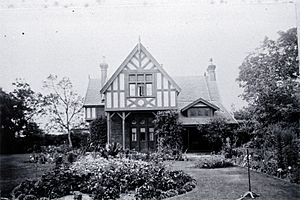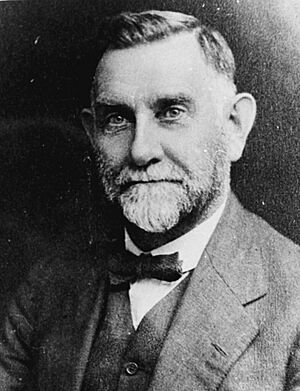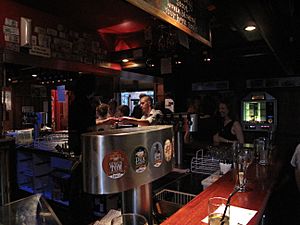Dux de Lux facts for kids
Quick facts for kids Dux de Lux |
|
|---|---|

Dux de Lux in 2010
|
|
| Former names | Llanmaes |
| General information | |
| Type | Residential, converted to a restaurant and bar |
| Architectural style | English Domestic Revival style |
| Location | corner Hereford and Montreal Streets, Christchurch Central City |
| Address | 41 Hereford Street |
| Town or city | Christchurch |
| Country | New Zealand |
| Coordinates | 43°31′54″S 172°37′49″E / 43.5318°S 172.6302°E |
| Current tenants | nil (closed due to earthquake damage) |
| Completed | 1883 |
| Renovated | 1928/29 |
| Client | John Lewis |
| Owner | Art Centre Trust |
| Landlord | Art Centre Trust Board |
| Technical details | |
| Floor count | two |
| Design and construction | |
| Architect | Francis Petre |
| Renovating team | |
| Architect | Collins and Harman |
| Official name: Arts Centre of Christchurch Old Student Union Building | |
| Designated: | 26 November 1981 |
| Reference #: | 4907 |
The Dux de Lux was a well-known restaurant and bar in Christchurch, New Zealand. Its name comes from Latin, meaning "Masters of the Finest." The building was originally called Llanmaes. It is part of the Christchurch Arts Centre and was once a private home. Later, it became the student union building for the University of Canterbury. The university moved to a new location, and the building was then turned into the Dux de Lux.
This building is considered a special heritage site. It is listed as a Category II heritage building by Heritage New Zealand. Sadly, the Dux de Lux building closed after the 2011 Christchurch earthquake because it was badly damaged. The restaurant and bar then moved to different places in the suburbs.
Contents
Where is the Dux de Lux?
The Dux de Lux building stands on its own. It is located at the corner of Hereford and Montreal Streets in central Christchurch. Today, it is part of the Arts Centre complex. This area is known as a cultural hub in the city.
History of the Building
The building was first built as a private home for a merchant named John Lewis. It was finished in 1883. The famous architect Francis Petre designed it in a style called Tudor Revival. John Lewis named his new home Llanmaes, which is a Welsh name meaning 'the church in the meadow'.
The house changed owners a few times. In 1899, Dr. Colin Graham Campbell bought it. Then, in 1904, Dr. Charles Chilton became the owner. Dr. Chilton was a very important zoologist. He was the first person in Australasia to be appointed as a rector (a top university leader). He was also the first person in New Zealand to earn a D.Sc. degree. He lived in the house until 1911.
In 1926, the University of Canterbury bought the building. For the next three years, it was used as the rector's home.
The University and Student Union
Canterbury College, which later became the University of Canterbury, started in 1872. The college bought Llanmaes as the last building on its city block.
The Canterbury Students' Association was formed in 1894. They wanted a place for students to meet. In 1921, they got a tearoom, but they really wanted their own building. They even had a design competition for a new building. However, the estimated cost of £30,000 was too much.
The university suggested that Llanmaes, which they had just bought, could be used by the students. Even though the students first said no, architects Collins and Harman were asked to plan how to make the building bigger. They kept the original English Domestic Revival style. In 1928–1929, they added more parts to the building and low brick walls outside. From 1929, the building became the Student Union.
In 1954, a fire damaged much of the inside. But in 1955–1956, new parts were added, including a dining room and meeting rooms. After the student union moved out, the building was turned into a bar, music place, and restaurant. The Dux de Lux opened its doors in late 1978.
The New Zealand band Salmonella Dub released a song called Same Home Town in 2013. They dedicated it to the Dux de Lux because it was one of their early performance venues in Christchurch.
The 2011 Earthquake and Beyond
The Dux de Lux building was badly damaged in the 22 February 2011 Christchurch earthquake. Because of this, it had to close down. The entire Arts Centre also had to close due to severe damage. This meant the Dux de Lux, which was famous for its vegetarian and seafood dishes, had to leave.
Later in 2011, a music venue called Dux Live! opened in Addington. Then, in 2012, Dux Dine opened in the nearby suburb of Riccarton. The Dux Brewing Company still makes and sells craft beer, like their popular Ginger Tom.
Building Design
The Dux de Lux building has an English Cottage style, influenced by Tudor designs. It has several parts connected together. On the west side, there is a two-story Brew Bar with offices above. On the north side, there is a single-story Tavern Bar. In the northeast corner, there is a two-story wing that includes a restaurant and a Function Room. The southeast corner has stairs, restrooms, and an office.
The roof is made of slate tiles. The building has timber frames for the roof and floors. The outside walls and some inside walls are made of double brick. The inside walls are finished with lath and plaster. There is a brick chimney on the west wall and a bay window on the north wall. The building also has beautiful stained glass windows and brick arches at the entrances. In 1929, it had rimu wood panels and wallpaper in soft colors.
Heritage Status
The Dux de Lux building was officially recognized as a Category II heritage building on 26 November 1981. This was done by the New Zealand Historic Places Trust, with registration number 4907. It is a good example of architect Francis Petre's work on homes. He is more famous for designing large churches, like the Cathedral of the Blessed Sacrament in Christchurch.
The building is important because it was home to the University of Canterbury's student union for 40 years. Many former students feel it was a central part of their university life.




